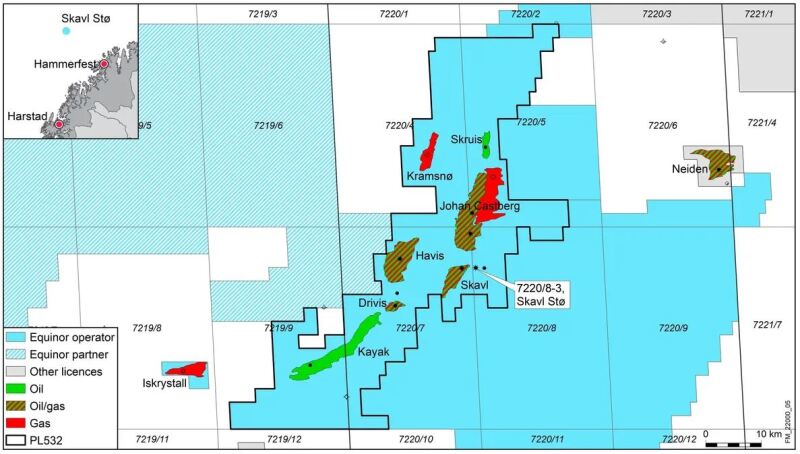Two weeks after announcing a new discovery in the Barents Sea, Norway’s Equinor is back with news that it has successfully found oil and gas at another location.
Although it is significantly smaller than the previous find, the Skavl Stø discovery is well within tieback distance to the giant Johan Castberg field found just 3 miles to the north.
Early data suggest that the Skavl Stø discovery contains a recoverable volume of between 5 to 10 million BOE. This compares to the estimated 37 to 50 million bbl of recoverable oil the majority state-owned operator announced it found in May at the Snøfonn Nord field.
The back-to-back discoveries were made in locations separated by less than a mile. They also come a year after Equinor drilled a wildcat well at the Isflak field that may hold an additional 31 to 51 million bbl of recoverable oil.
Skavl Stø represents the thirteenth exploration well in the Castberg license area, all but one of which have successfully found oil and gas deposits. These satellite fields and several others that Equinor is amassing around Johan Castberg may play a key role in that project’s long-term development.
“The new discovery and information will be viewed in the light of other discoveries in the area, and together with our partners we will consider further development of the area,” Kristin Westvik, senior vice president for exploration and production north for Equinor, said in a statement.

Found at depths of around 1,200 ft, Johan Castberg lies about 150 miles offshore Norway’s northern coast. The field is a conglomeration of three discoveries: Skrugard in April 2011; Havis in January 2012; and Drivis in May 2014.
Until these discoveries were made, Equinor and others had struggled to find quality reservoirs in the Arctic waters of the Barents Sea. And despite being the biggest field ever found in the Barents Sea, independent studies of Johan Castberg suggest it may enjoy only a few years of peak production before entering a state of steady decline. This scenario is based on an accelerated production plan that pegs the overall production span of Johan Castberg at around 27 years.
Equnior is aiming to extend the project’s peak plateau and produce oil and gas from the field for at least 30 years. Coupling the additional volumes of recent discoveries made near Johan Castberg will aid Equinor in achieving this goal.
The development plan for Johan Castberg was approved in 2017 after facing delays and a reengineering to dramatically lower its development cost. The delays were initially attributed to the failure of exploration efforts to realize enough recoverable reserves to justify a newbuild platform that carried an estimated price tag of around $4 billion.
A revised plan calling for a floating production, storage, and offloading unit, or FPSO, cut the estimated project cost in half. As a result, the originally estimated minimum breakeven of more than $70/bbl was slashed to Equinor's current estimate of $30/bbl.
The project faced further delays caused by the COVID-19 pandemic which pushed the target date for first oil from 2022 to the fourth quarter of 2024.
The Johan Castberg FPSO is currently at a shipyard on the Norwegian mainland where Aker Solutions is installing the final production systems. The FPSO is designed to produce up to 190,000 B/D from 18 producing wells which will be supported by 12 injector wells.
Equinor holds a 50% ownership share in the Johan Castberg project, with its partners Vår Energi holding 30% and Petoro 20%.


